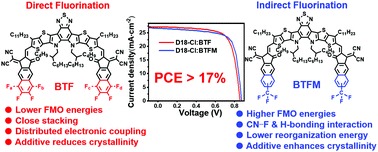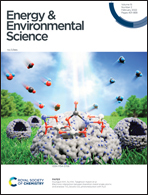Non-fullerene acceptors with direct and indirect hexa-fluorination afford >17% efficiency in polymer solar cells
We show that both direct and indirect fluorination modalities can significantly enhance the corresponding OSC performance under different fabrication conditions.

Technology Overview
This work first develops the synthesis of two new hexafluorinated NFAs with different EG fluorination modalities, which when blended with the donor polymer D18-Cl afford PCEs as high as 17.3%. These metrics closely rival the current literature record of 18% and argue that OPVs remain a viable strategy for efficient solar energy capture.
Applications & Benefits
The contrasting role of the additive in BTF and BTFM cells is further clarified by recombination dynamics analysis using in situ photocurrent and impedance spectroscopy. Overall, this work provides guidance for developing new NFAs via direct and indirect fluorination strategies for high efficiency OSCs.
Abstract:
The rational molecular design of non-fullerene acceptors (NFAs) in organic solar cells (OSCs) can profoundly influence the photovoltaic (OPV) performance. To date, NFA fluorination has proven beneficial to cell performance. However, there is a lack of comprehensive understanding of how various fluorination modalities influence film morphology, carrier mobility, molecular packing, other structural properties, electronic structure, exciton separation, and charge transport, that determine ultimate cell efficiency. Here, we compare two types of end group (EG) fluorination patterns on Y6-based A-DAD-A cores, resulting in highly efficient NFAs: direct skeletal fluorination (BTF) and indirect trifluoromethyl fluorination (BTFM). These two patterns induce distinctive behaviors in the active layer blends with a chlorinated donor polymer D18-Cl and the additive, 1-chloronaphthalene, affording high PCE values of 17.30% (BTF + additive) and 17.10% (BTFM, no-additive). The BTFvs.BTFM OSC performance trends can be correlated with diffraction-derived differences in molecular packing. Density functional theory (DFT) reveals remarkably low internal reorganization energies and high electronic coupling between NFA dimers, greater and more numerous than in other NFAs reported to date, thus providing extended 3D charge transport networks in the thin film crystalline domains. Transient absorption spectroscopy reveals that hole transfer from the acceptor to the donor occurs in <300 fs and that photoexcited carriers persist for hundreds of ns in each blend film. The contrasting role of the additive in BTF and BTFM cells is further clarified by recombination dynamics analysis using in situ photocurrent and impedance spectroscopy. Overall, this work provides guidance for developing new NFAs via direct and indirect fluorination strategies for high efficiency OSCs.

Non-fullerene acceptors with direct and indirect hexa-fluorination afford >17% efficiency in polymer solar cells
Author:Guoping Li, Liang-Wen Feng, Subhrangsu Mukherjee, Leighton O. Jones, Robert M. Jacobberger, Wei Huang, Ryan M. Young, Robert M. Pankow, Weigang Zhu, Norman Lu, Kevin L. Kohlstedt, Vinod K. Sangwan, Michael R. Wasielewski, Mark C. Hersam, George C. Schatz, Dean M. DeLongchamp, Antonio Facchetti, Tobin J. Marks
Year:2022
Source publication:Energy & Environmental Science Volume 15 ,Issue 2 17545692
Subfield Highest percentage:99% Pollution #1/132
https://pubs.rsc.org/en/content/articlelanding/2022/ee/d1ee03225a
